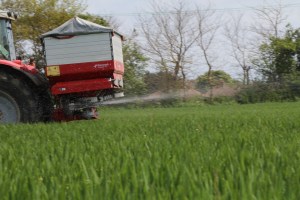As new season fertiliser purchasing begins, how will the new Defra requirements regarding the use of urea affect the coming season? CPM finds out.
There are several urease inhibitors on the market, and all of them will effectively limit volatilisation after spreading by upwards of 70%.
By Rob Jones
Although urea accounts for 80% of the world’s nitrogen fertiliser, the high potential losses of ammonia following application has meant it has been labelled as a problem in Europe as agriculture strives to reduce emissions.
The trouble with ammonia is that it’s a serious air pollutant and the UK has set targets to reduce ammonia emissions by 16% compared with 2005 levels by the end of the decade. And as agriculture accounts for 87% of the UK’s ammonia emissions output, it has long been a key target for improvement.
Recent price fluctuations and supply issues constraining the availability of ammonium nitrate (AN), have caused issues for farmers sourcing products, and this has meant urea’s use has increased for growers looking for crop nutrition alternatives.
To help clean up urea’s act, Defra’s Clean Air Strategy has thrown into sharp focus how agriculture can take action to reduce these harmful emissions. Three options for future urea use have been considered, including using urea protected with urease inhibitors, a restricted spreading window for urea and an outright ban on the product. However, Defra recently reaffirmed that it has selected ‘Option 4’, which will apply for urea applications to crops in England from 1 April 2024.
This fourth option was an industry-led initiative by bodies including AIC, NFU, BASIS, NIAB, Red Tractor, AICC and CLA, with the primary aim to keep access to urea for market competition but minimise the ammonia losses from volatilisation.
Peter Scott, technical director at Origin Fertilisers, explains why he believes Defra’s commitment to Option 4 is good news for farmers: “Option 4 means farmers wishing to spread urea fertilisers beyond 1 April 2024 will have to apply protected urea products that feature urease inhibitors,” he says. “There are several urease inhibitors on the market, and all of them will effectively limit volatilisation after spreading by upwards of 70%.

“There’s potentially substantial increases in nitrogen use efficiency compared with untreated urea, which will make any fertiliser investment go further,” says Peter Scott.
“Along with this, there’s potentially substantial increases in nitrogen use efficiency compared with untreated urea, which will make any fertiliser investment go further.”
Compliance for the new scheme will be monitored through Red Tractor farm assurance and non-compliance could result in potential regulation, but this is something the industry is keen to avoid, as maintaining access to urea is crucial for a competitive fertiliser market, adds Peter.
The voluntary scheme sets out that between 1 April and 1 September for arable, or from 1 April to 15 September for grassland, urease inhibitors should be used for fertilisers containing urea. From a practical perspective, Option 4 will effectively come into force on 1 April 2024, and relates to all solid and liquid fertiliser containing urea, which Peter says is a key point to note.
“Any fertiliser with 1% urea or above is included in the scheme and growers should be aware that this covers any compound fertiliser containing urea, for example NP and NPKs, and not just straight urea. AIC is working with Defra to collate the data and ensure efficacy of the products on the market, along with encouraging compliance from farmers.”
A product type that the compliance does not cover is foliar urea due to the tendency to use this in small amounts, specifically as a late season ear wash to boost grain nitrogen. However, there’s been an uptick in foliar urea use to replace part of the main spring nitrogen programme due to the recent price increases in solid and liquid nitrogen fertilisers.
“Growers should be aware that foliar urea is not typically protected with a urease inhibitor and those looking to replace part of their N by applying it in the spring should consider this before deciding,” advises Peter.
There are two distinct types of urease inhibitors currently on the market and both are effective. However, it’s important to be clear about how each inhibitor works to ensure the most suitable product is utilised for the farm to make the most of the fertiliser being applied, he adds.
Phosphoric triamides, such as NPBT (Sustain), NPBT/ NPPT (Limus) and 2-NPT (Alzon Neo-N), are widely known and available in both solid and liquid fertilisers. These all use the same mode of action, which slows urea hydrolysis and the risk of ammonia volatilisation by forming an analogue of urease to block active sites.
The other type of urease inhibitor available contains a carboxylic carbohydrate as Nutrisphere in Origin Enhanced Nitrogen (OEN) and in liquid form as Liqui-Safe from Agrii. It has been on the market as an inhibitor since 2009 and gained EC certification in 2023. A key difference here is that nickel – a catalyst for the urease enzyme – is sequestered by Nutrisphere to slow down urea hydrolysis and ammonia volatilisation, explains Peter.
“Nutrisphere is a combination of organic acids which use their naturally high cation exchange capacity to temporarily sequester nickel in the soil,” Peter explains. “The effect is two-fold, as well as reducing volatilisation, Nutrisphere also acts as a nitrification inhibitor by sequestering the catalysts for nitrifying bacteria and reducing the risk of nitrates leaching into water.”
This was proven through research by NIAB Tag and John Innes Centre, which assessed the availability of soil N at different depths and timings after applications of UAN with Nutrisphere. The first application of UAN was assessed after six days at 25% soil moisture and showed a reduction in movement of nitrate in the 10cm soil band by 40%. At 11 days post-application, Nutrisphere reduced nitrate levels in the 60cm band by 55%.
Nutrient compatibility
Growers should be looking at the various strengths of each inhibitor before deciding which type to purchase. Phosphoric triamides are highly effective at reducing volatilisation, but they are degraded by exposure to the atmosphere, acidity and high temperatures.
Another area that should be of utmost importance to those wishing to use NP and NPK fertilisers containing urea is the compatibility – or incompatibility – of urease inhibitors with phosphate.
“Incompatibility with phosphate has always limited the use of phosphoric triamides in NP and NPK fertilisers as rapid degradation caused by the acidity in phosphates has reduced the efficacy of the inhibitor,” Peter explains of the difference between the two types of inhibitor. “However, for growers after N, NS and NPK fertilisers, Nutrisphere offers compatibility with phosphates and other nutrients to remain stable in the bag for 12 months and still maintain product efficacy when spreading.”
The technical dossier submitted for EC certification of Nutrisphere as a urease inhibitor also used evidence around environmental protection, such as positive impacts on soil bacteria, earthworms and marine life, even at ten times the recommended dose. Detailed research by the University of Athens into the impact on soil bacteria between Nutrisphere and unprotected urea found there was a 10% increase in soil bacteria survival after 64 days following application.
Fertiliser choices for next season
As new season fertiliser purchasing is already underway, farmers will have some tough choices to make regarding which route to take, and that means carefully considering the requirements of Option 4.

As new season fertiliser purchasing is already underway, farmers will have some tough choices to make regarding which route to take
“When buying fertiliser, growers should be questioning their use period and if they will have urea products to apply beyond 31 March 2024,” Peter advises. “Getting advice from a qualified FACTS advisor will help inform growers on which inhibitor is best for their circumstances and if all urea products need to feature a urease inhibitor.”
AIC has said it is working with DEFRA to establish a new national fertiliser regulation, which will include urease inhibitors. This, they say, will provide greater clarity on some issues that farmers are battling with, such as the new terminology around protected urea, efficacy and limits of use.
Peter Scott concludes that although it is a new scheme to comply with, the benefits are far-reaching. “Given the potential nitrogen losses from urea, using a urease inhibitor more than pays for itself through increased nitrogen use efficiency.
“At the same time, reductions in the harmful air pollutant ammonia, and the proven positive impacts to environment, means there is plenty of potential for agriculture to increase its fertiliser efficiency.”
For more articles like this, subscribe to CPM here, and get the latest articles direct to your inbox by signing up for our FREE e-newsletter here.




